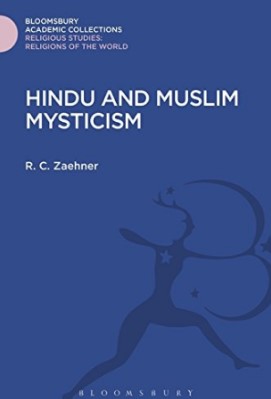
| Hindu And Muslim Mysticism |
| R. C. Zaehner |
| 258 |
| |
| PDF Direct Download Link |
| Click for Hard Copy from Amazon |
HINDU AND MUSLIM MYSTICISM – Book Sample
PREFACE – HINDU AND MUSLIM MYSTICISM
This volume consists of eight lectures delivered (in a slightly abridged form) in May 1959 at the School of Oriental and African Studies in the University of London, when I had the honour of being invited by the Director and the Academic Board of the School to give the fifth series of Lectures under the Louis H. Jordan Bequest.
I chose the subject of Hindu and Muslim Mysticism because it seemed to me that, voluminous as the literature on mysticism is, much of it starts from the quite unproven premises that mysticism is a more or less uniform phenomenon appearing in all the great religious traditions.
So far from this being the case, certain varieties of mystical experience are attested not only in different mystical traditions but also in the same religion. I chose the Hindu and Muslim varieties for three reasons:
first because I am better equipped to deal with these two than with any other, secondly because in Hindu mysticism the types are most easily and clearly distinguished, and thirdly because so little has been written on Muslim mysticism in English.
I have treated the two streams of mysticism separately, the fırst four lectures being devoted mainly to Hinduism and the last four to Islam. Constant reference from the one to the other, however, has been made throughout wherever such comparison seemed illuminating, as has surprisingly often proved to be the case.
I have not, of course, attempted to cover the whole field of either Hindu or Muslim mysticism since that would not have been possible in eight lectures, but I have attempted to trace the development of mystical thought within the formative period of both traditions.
in the case of Hinduism, I have concentrated on what seemed to me to be salient in the ‘classical’ Upanişads, the Yogasütras, the Bhagavad-Gita, and lastly on Ramanuja’s commentary on the latter. Similarly, in Islam I have concentrated on what can be called the monistic revolution introduced into Muslim mysticism by Abü Yazid of Bistam in the ninth century, on the restoration of the theistic balance by Junayd of Baghdad, on the re affırmation ofa pure monism in Ghazali’s later writings, and on the refutation of this by Ibn Tufayl in the name of sanity and by Najm al-Din Razi in the name of islamic orthodoxy.
The book may be regarded as the vindication on a smaller scale and in a narrower fıeld of the theory of mystical experience I evolved in my former book Mysticism Sacred and Profane. Particular stress has been laid on the theistic interpretation of the ‘monistic’ type of mystical experience in which the mystic claims identity with the ‘üne’ because the opposite view of the absolute monists has, ever since the time of Deussen, received far more attention than it would appear to merit.
Further I have attempted to show in some detail that the monism of Abü Yazid, so far from being a natural or inevitable growth in Islam, is, on the contrary, a direct infiltration from an Indian source.
If this book has succeeded in introducing some small element of clarity into the study of mysticism, it will not have been written in vam.
In conclusion I would thank Dr. S. M. Stern of this college for the great trouble he took in checking through my Arabic versions. Any inaccuracies that may remain are, of course, entirely due to me. I would also thank Mr. John Caute also of this college for his great kindness in helping me with the always tedious business of checking the index references.
The God of Love
WE saw in the last lecture that, in the fırst six chapters of the Gita, liberation was regarded as ‘becoming Brahman’,
which seems to mean, as it does in Buddhism, to enter into an eternal form of existence. The term brahman seems to be formally equated with the Buddhist nirviiı;ıa in the compound brahmanirviiı;ıa.1 We shall now have to consider first the relationship of Krishna as God to Brahman as the impersonal Absolute, and secondly his relationship to the released soul which, as brahmabhüta, has already realized itself as Brahman.
The general impression conveyed by the last two-thirds of the Gita is that God both is Brahman and is yet higher than it. Let us see whether a closer examination of the text enables us to be more precise.
We must fırst consider one passage in which God would appear to be only an aspect of Brahman: Brahman [the text reads], is the supreme Imperishable; it is called Nature in its relationship to the humarı person (adhyatmam); as the creative force known as karma it causes the conditions of contingent being to come into existence. in its relationship to contingent beings, it is what is subject to coming-to-be and passing away (kşaro bhiivab). in its relationship to the gods it is Puruşa. in its relationship to sacrifıce I anı it here in the body. 2
To read more about the Hindu And Muslim Mysticism book Click the download button below to get it for free
Report broken link
Support this Website
for websites